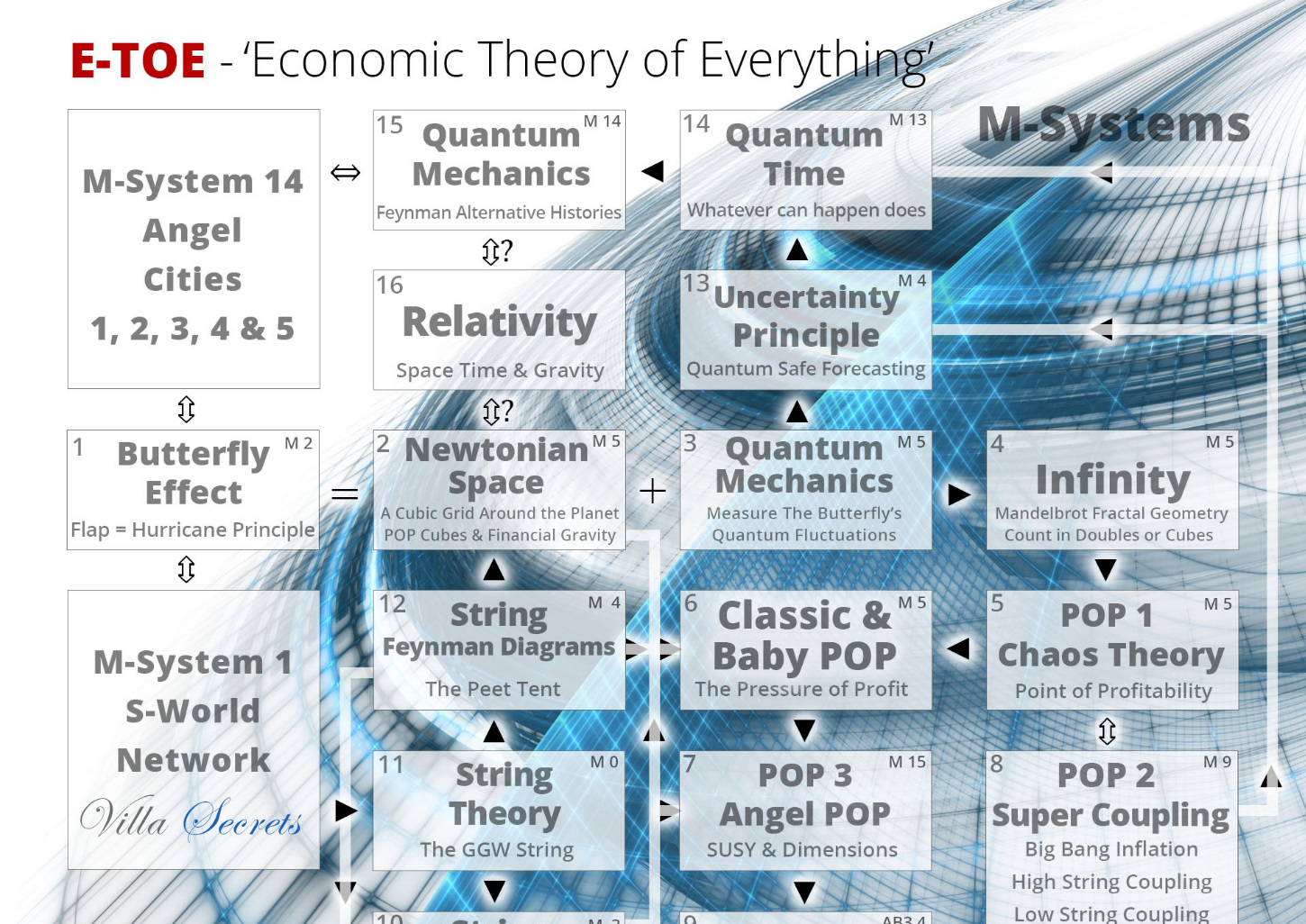A-Good-Model
Chapter 1. A Good Model
By Stephen Hawking from
The Grand Design
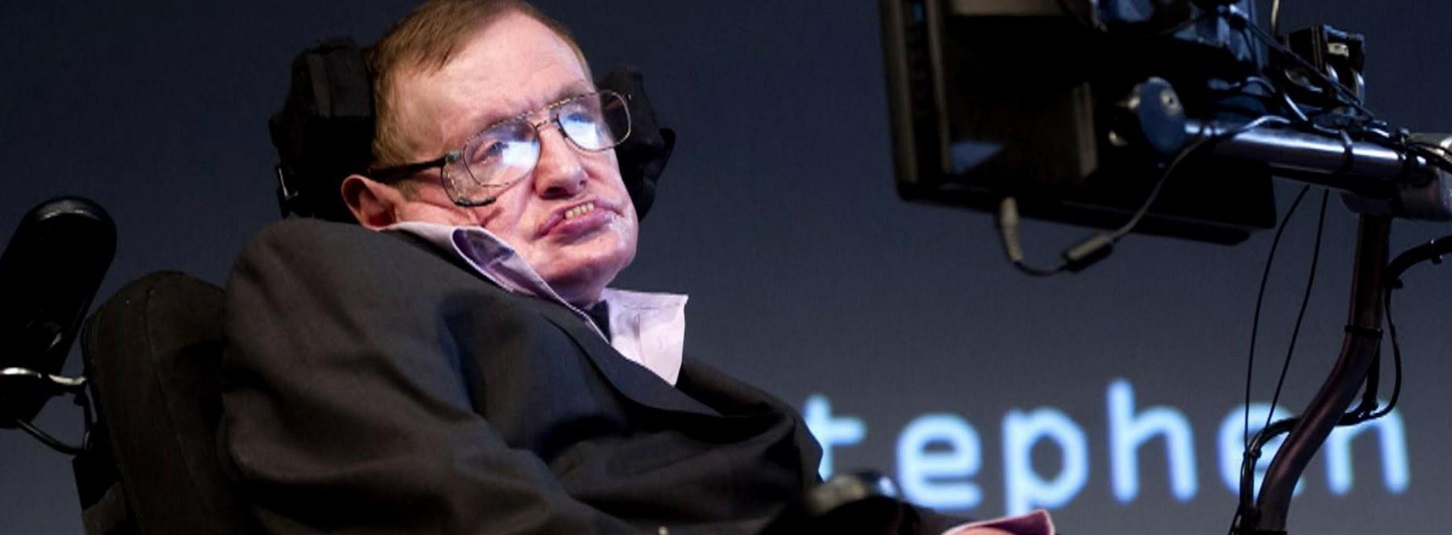
A model is a good model if it:
1. Is elegant
Elegance is not something easily measured, but it is highly prized amongst scientist because laws of nature are meant to economically compress a number of particular cases into one simple formula.
Elegance refers to the form of a theory, but it is closely related to a lack of adjustable elements, since a theory jammed with fudge factors is not very elegant. To paraphrase Einstein, ‘a theory should be as simple as possible, but not simpler.’
2. Contains few arbitrary or adjustable elements
3. Agrees with and explains all existing observations
4. Makes detailed predictions about future observations that can disprove or falsify the model if they are not borne out.
1. Elegance
Starting with:
‘Elegance is not something easily measured, but it is highly prized amongst scientist because laws of nature are meant to economically compress a number of particular cases into one simple formula.’
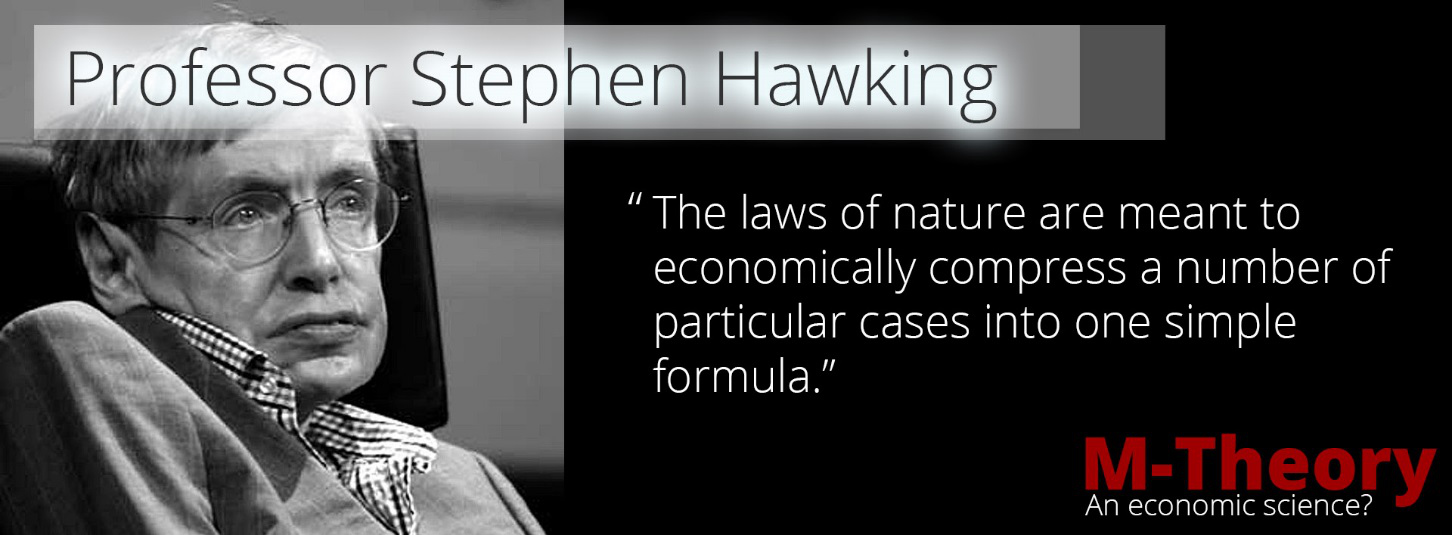
From The Grand Design
Professors Stephen Hawking, Leonard Mlodinow
Also found in ‘The Grand Design,’ Hawking and Mlodinow tell that the laws of nature are fine-tuned due to billions of years of effort.
“So, maybe, by mimicking, simulating, and following the laws of nature at every turn, the end result for an economic system based on mother nature would be for it also to be economically compressed.”
This has both immediate advantages in economic efficiency, plus it also gives us a map of sorts where we can choose future actions based on the best ‘metaphor,’ from theoretical physics related math and in particular String Theory.
Add this collaboration with classic economics, macroeconomics, and the behavioral sciences and a few million hours of software development and you could really have something.
The argument goes that because the economics are mostly mimicked from one or another law of nature, then the economic theory would likely be both economically compressed and elegant. Albeit it is not for me to say my own work is elegant.
In terms of Einstein’s comment, ‘a theory should be as simple as possible, but not simpler,’ Einstein’s own theories required a lot of detail, thus a lot of detail is obviously permissible, even if the essential points are in themselves simple enough.
2. Contains few arbitrary and adjustable elements
Since reading Hawking’s work about 2 years ago , I have refined the model around a set of simple laws including ‘The Peet Tent,’ ‘The Susskind Boost,’ ‘POP,’ ‘Give Half Back,’ and ‘ŔÉŚ’; which have mixed with the founding assumptions, such as the creation of the next generation software for small and big business in the TBS™ (Total Business Systems) (Book 4) , VSN™ (Virtual Social Network), and the creation of S-World VSN™ Virtual Social Network (Book 5), and the game/simulation/tutorial/recruiting software S-World UCS™ Simulator (Universal Colonization Simulator) (Book 7); all of which collectively help to monitor and organise all companies around these simple laws.

For the most part, the basic laws are all that is required. However, stemming from the basic laws via the various software systems are a great many options (like mother nature has made many wonderful plants and animals), but the options can never break the laws.
3. Agrees with and explains all existing observations
In this case, importantly, I have done business management, business psychology, behavioral economic, general economics, and macroeconomic research and due diligence on the business and economic S-World model; carefully reading and studying a number of relevant books, listed in the order of acquiring.
a. Brian Tracy, ‘The Psychology of Selling: Increase Your Sales Faster and Easier Than You Ever Thought Possible’
b. Matthew Dixon and Brent Adamson, ‘The Challenger Sale: Taking Control of the Customer Conversation’
c. David E. McAdams, ‘Game-Changer: Game Theory and the Art of Transforming Strategic Situations’
d. David Hoffeld, ‘The Science of Selling: Proven Strategies to Make Your Pitch, Influence Decisions, and Close the Deal’
e. Deepak Malhotra and Max Bazerman, ‘Negotiation Genius: How to Overcome Obstacles and Achieve Brilliant Results at the Bargaining Table and Beyond’
f. Thomas Piketty, ‘Capital in the Twenty-First Century’
g. David A. Moss, ‘A Concise Guide to Macroeconomics: What Managers, Executives, and Students Need to Know’
h. Michael Lewis, ‘The Big Short: Inside the Doomsday Machine’
i. Richard Thaler, ‘Misbehaving: ‘The Making of Behavioral Economics’
j. Richard Thaler and Cass Sunstein, ‘Nudge: Improving Decisions about Health, Wealth, and Happiness’
So far, in terms of the economics and certainly macroeconomics and behavioral economics, there is nothing contradictory in the model I am presenting.
In fact, if we break current economics in two, with traditional and macroeconomics on the one side and behavioural economics on the other, S-World economics can unify the two. And this is how…
Classic and Macroeconomics assume that every person on the planet is an expert at everything economics related, from choosing retirement plans to how much to spend on their daughter’s 21st Birthday. Whereas behavioral economics rightly suggests that, as humans, we are not experts at everything and we make mistakes.
In this regard, behavioral economics is not saying that all of classical and macroeconomics are different; instead, in my opinion, behavioral economics is the fine-tuning of classic economics to individuals.
In ‘The Villa Secrets’ Secrets,’ written in stages from 2014 to mid-2017, we can see many systems such as:
Chapter 1. The S-Web CMS Framework
Chapter 4. The S-Web CDS – Content Delivery System
Chapter 6. The S-World CRM Nudge Ai
Chapter 7. The S-World TFS – Total Financial Systems
Chapter 9. The CRM CC – Company Controller
And most recently, a new system, and indeed a whole new line of software has been created:
S-World BES™ – Behavioural Economic Systems
(A TBS™ & UCS™ sub system)
In fairness, the first BES™ system was the grandly named QuESC – Quantum Economic System Core.’ M-System 11.
From Book 1. M-Systems. Chapter 3. The S-World UCS M-Systems
M-System 11 – QuESC (The Quantum Economic System Core) (2012 – 2018)
The heart of the M-System’s design is founded on the notion by Hawking that ‘People are like Atoms,’ QuESC entangles us ‘the people’ with powerful predictive and logistic software within a circular butterfly effect, continually experimenting and improving upon all S-World systems.
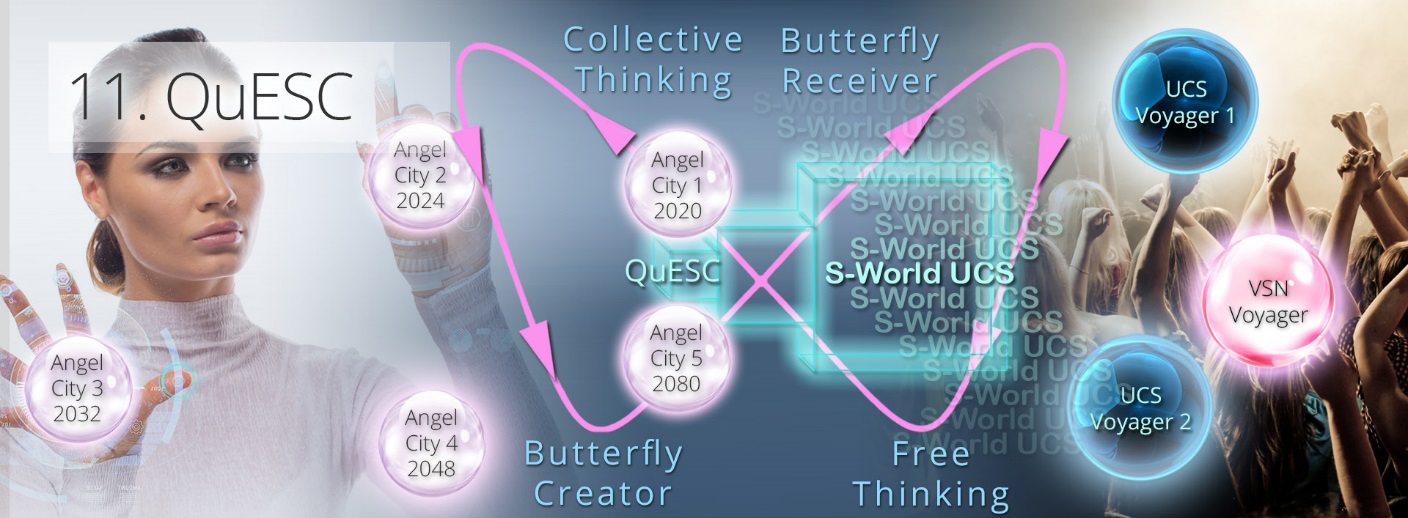
The quantum idea behind QuESC was simply that the billions of humans on this planet, all following their own free will and rarely making the best economic choices, become the uncertainty and the free will thinking intelligence within the S-World software and systems.
Fashioned like a butterfly’s wings, the ultimately circular path of software and S-World UCS™ personnel creating options; to be received and acted upon by the public/users who apply free thinking, where after the results are received and processed by the software and S-World UCS™ personnel, before sending out new opportunities that have benefited from the ‘free thinking’ and the software collectively, and round and round it goes…
This butterfly graphic and QuESC were featured first in American Butterfly Book 2. ‘Spiritually Inspired Software.’
So, we see that there has been a significant behavioural science idea at the heart of the software (as the system core is the heart of the software).
And so, 6 years on from the first idea of QuESC, I introduce…
The Villa Secrets’ Secret – Chapter 10
BES™ 1. S-World UCS™ Hawthorne
Network.villasecrets.com/the-secret/ch10/UCS-Hawthorne-for-Richard-Thaler
Introducing…
S-World BES™ ‘Behavioral Economic Systems’
This chapter opens up a new breed of software based on behavioral science, S-World BES™.
S-World UCS™ Hawthorne is the first software created specifically from an inspiration from behavioral economics.
Unlike all other software designs presented in ‘The Villa Secrets’ Secret’ which all are part of S-World TBS™ ‘Total Business Systems,’ because the Hawthorne Effect is best described as a game, a competition with winners and losers every day; it falls under the S-World UCS™ banner, as S-World UCS is the Gaming, Tutorial, & Simulation Software components to the S-World network.
The Hawthorne Effect
“The Hawthorne effect (also referred to as the observer effect) is a type of reactivity in which individuals modify an aspect of their behaviour in response to their awareness of being observed.”
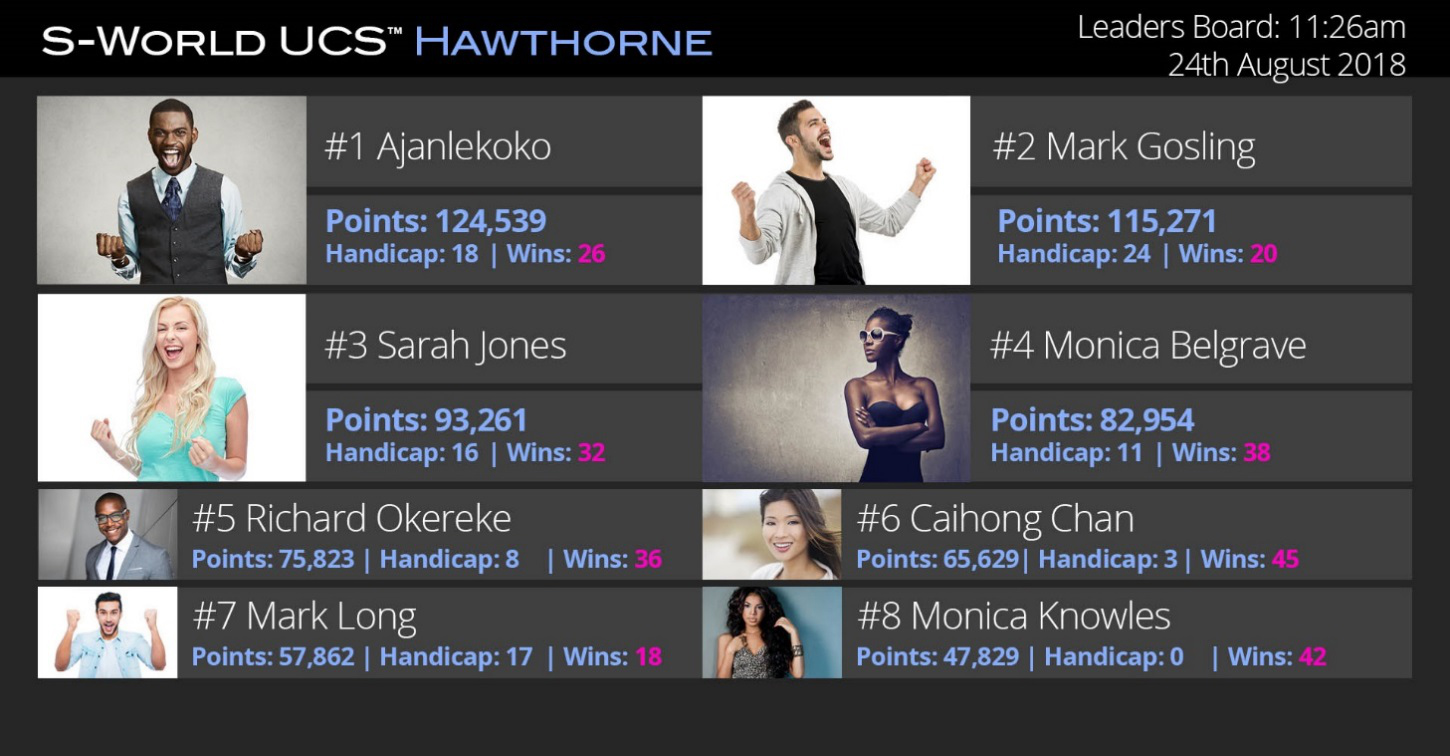
In brief, S-World UCS Hawthorne turns each work day into a day to win and makes a game out of it; including handicaps for new or just not so good players. So, any day, anyone can win. In an example for HMRC, one wins only the recognition of your peers and the attention of these who would promote and fire you. However, if the Hawthorne Effect is correct (which we have no reason to doubt), their every client interaction is there for all to see, in a simple points-based score. And when we say I’m not kidding, as this scoreboard is designed to be shown of a giant TV on the wall of the office.
Later, in the Villa Secrets (business) example, we see that daily wins range from 5 times the average salary to a lot more, and the combination of both Hawthorne Effect and financial incentive make for a far more productive team
This behavioral economic system and others help to unify classic economics with behavioral economics, as the systems make the staff behave the way the economists suggest they should.
Here is that link again:
BES™ 1. S-World UCS™ Hawthorne
Network.villasecrets.com/the-secret/ch10/UCS-Hawthorne-for-Richard-Thaler
The S-World BES™ systems are designed to work with current economics; and, to use the term coined by Thaler and Sunstein, ‘Nudge’ software users into making the right choices by giving them a list of options, all of which the S-World software deems to be good economics or good business.
Below is another pearl of wisdom from Professor Hawking which makes the case for Thaler and Cass’s argument.
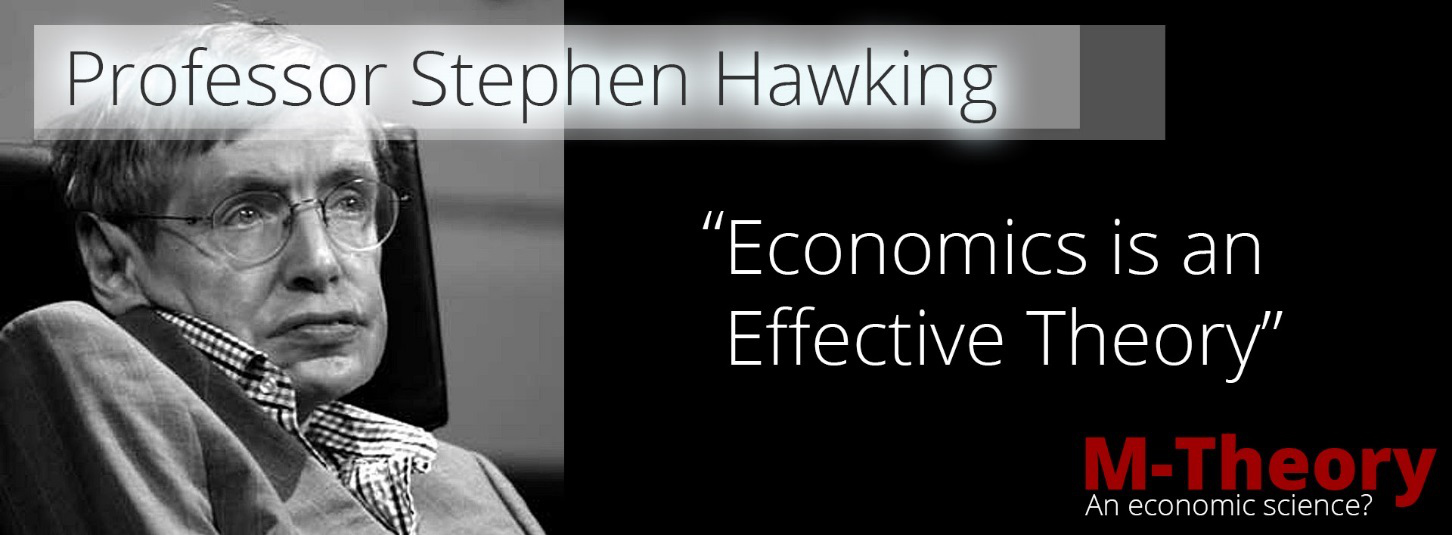
“In the case of people, since we cannot solve the equations that determine our behaviour, we use the ‘effective theory’ that people have free will. The study of our will, and of the behaviour that arises from it, is the science of psychology.
Economics is also an effective theory, based on the notion of free will plus the assumption that people evaluate their possible alternative courses of actions and choose the best.
That effective theory is only moderately successful in predicting behaviour because, as we all know, decisions are often not rational or are based on a defective analysis of the consequences of the choice.
That is why the world is in such a mess!
From The Grand Design
Professors Stephen Hawking, Leonard Mlodinow
Now, back to the last of Hawking’s ‘Good Model’ points:
4. ‘Makes detailed predictions about future observations that can disprove or falsify the model if they are not borne out.’
S-World was scientifically founded upon a line by Professor Isaac Asimov:
“You may not predict what an individual may do, but you can put in motion things that will move the masses in a direction that is desired, thus shaping if not predicting the future.”
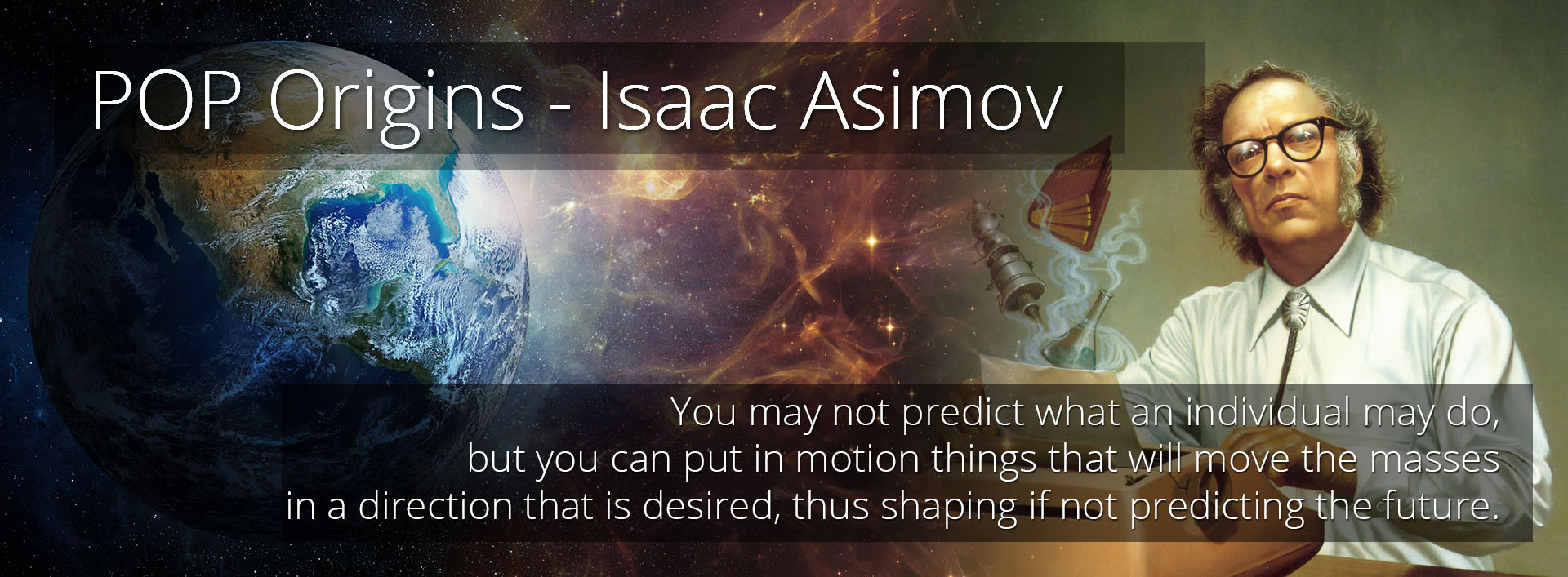
Five years later, this evolved into M-System 13 and 14. ‘The Quantum Systems.’
From Book 1. M-Systems
Chapter 3. ‘The S-World UCS™ M-Systems’…
Beginning of Extract
www.angeltheory.org/book/1-3/the-s-world-ucs-m-systems
M-Systems 13 & 14 – The Quantum Systems
Now, we arrive at arguably the main event; the S-World UCS quantum systems that create (first) an economic time machine, and then logistical anchors into the future; from which we desire to shape the world in a direction that is desired, via simulation and then implementation, to create a better future for our children and children’s children.
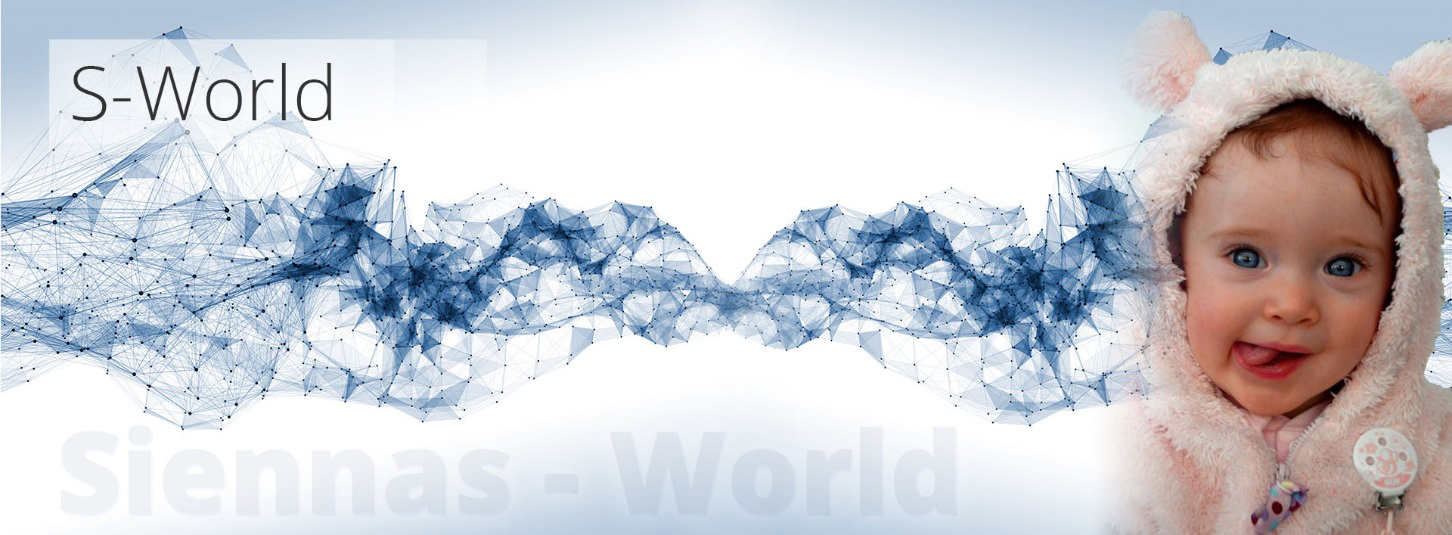
In the system design below, we can (at the bottom of the graphic) see the quantum systems flying out of M-System 12. S-World UCS™, scooping up Angel POP and the Angelverses on the way, delivering them full circle back to M-System 1. And as before, the circular rodeo starts again, but this time with greater momentum.
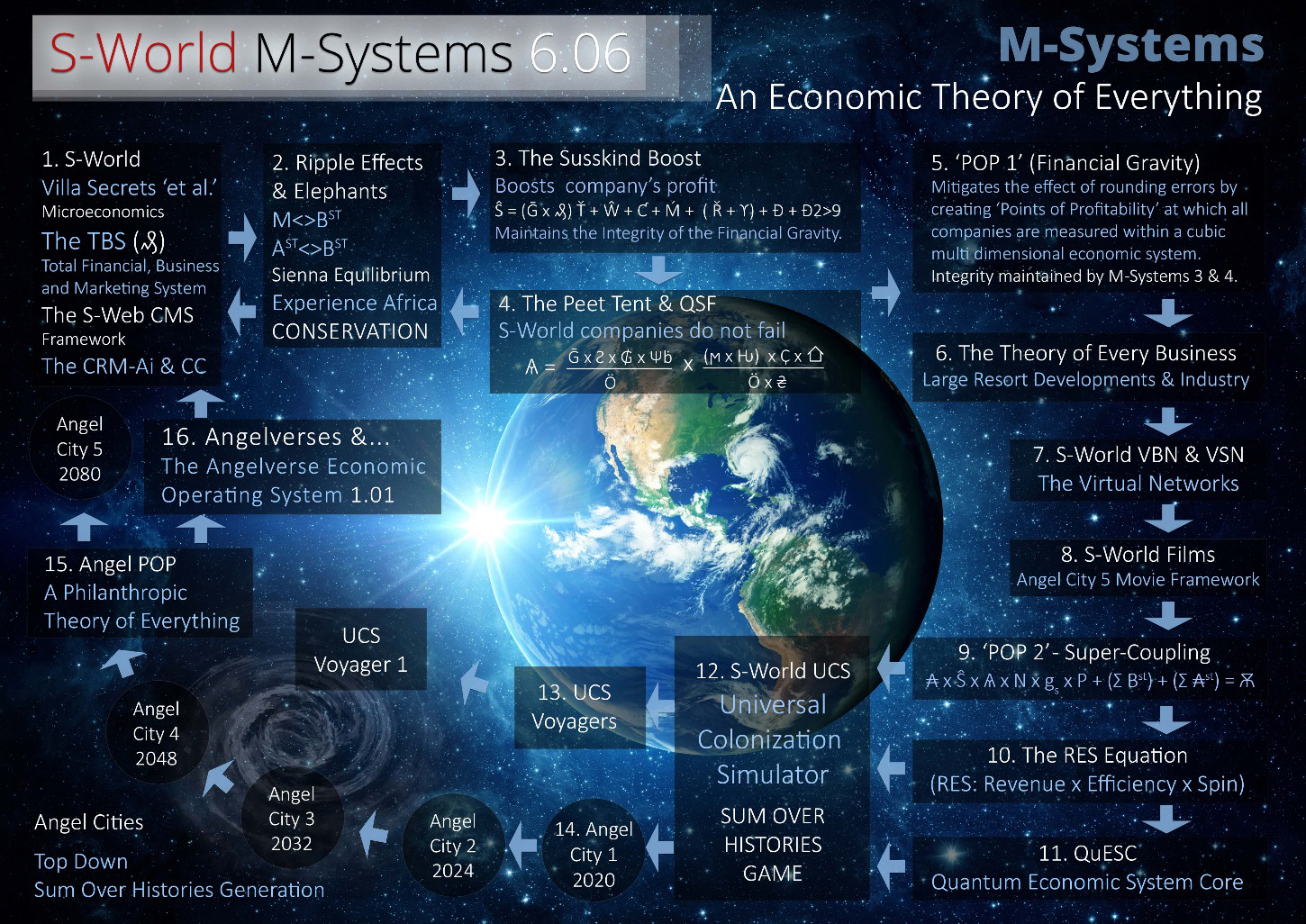
M-System 13 – Eureka!!! – S-World UCS Voyagers (September 2012)
The eureka moment arrived courtesy of Garrett Lisi’s ‘A Theory of Everything.’ In which Lisi presents his quantum coral analogy where “each individual was in many other locations experiencing them as separate individuals” and the quantum mechanics mantra:
“Everything That Can Happen Does.”
This revelation arrived in the middle of writing the final American Butterfly ‘Theory of Every Business’ chapter ‘S-World UCS,’ soon after writing the S-World VSN™ (Virtual & Business Network) chapter, in which the S-World UCS™ tutorial game sat within the virtual framework and had become entangled and indistinguishable from the conceptualised business network.

This consideration becoming the tipping point where a simulated game and business software became a form of economic time travel.
The consideration was that we would create a copy of the S-World UCS™ Network called ‘UCS Voyager’ and send it forwards in time at a speed twice our own. So that in 6 months of our time, the simulation would be a year ahead. And within, business owners, managers, staff, and gamers alike could conduct their own business simulations. Then, from all the possible outcomes, choose which actions from the simulations to follow back in real time.
Businesses follow the wins, avoid the losses, and replay opportunities that showed potential in Voyagers 2, 3, 4…

What if you could look to the future and see millions of eventualities?
What if you could use this information to assist you today?
Welcome to S-World UCS
Welcome to your future
M-System 14 – Eureka2 – S-World UCS Angel Cities (2012 – 2017)

Angel Cities are 5 future simulations of the network from 2020 to 2080; first created as logistical support for UCS Voyagers, but have since become a key ingredient, subject of the movie framework, and the ‘why’ behind the entire project. In terms of M-theory and its component quantum mechanics, we respect Professor Richard Feynman’s alternative histories (sum over histories) which tells us that no unobserved system has a definite past or future.
“Quantum physics tells us that no matter how thorough our observations of the present, the (unobserved) past, like the future, is indefinite and exists only as a spectrum of possibilities.”
From ‘The Grand Design’ by Professors Stephen Hawking & Leonard Mlodinow
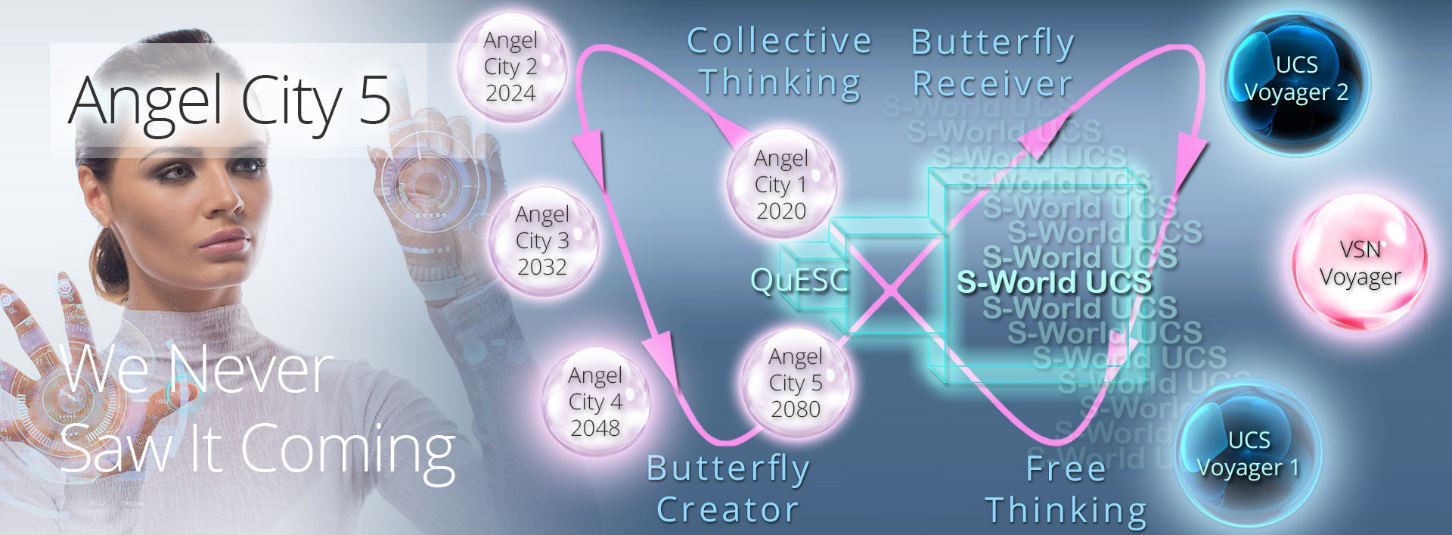
Shaping the Future
Set in the years 2048 and 2080, Angel Cities 4 and 5 are the nerve centre for the S-World network’s long-term ambitions, described as a set of ‘super projects.’ In this simulation, we work within the M-Systems framework to plan the best earth we can logistically create. And once the blueprint is set, we create paths back through Angel Cities 3, 2 and 1 so that each company, development, wonder, and ‘special project’ that we wish to exist in 2048 and later 2080 has a definite history back from the future to our time.
By planning our future in intricate detail and working in waves of probability, ripple & butterfly effects back through the future Angel Cities, we can control our destiny.
Angel City 5 (2080)
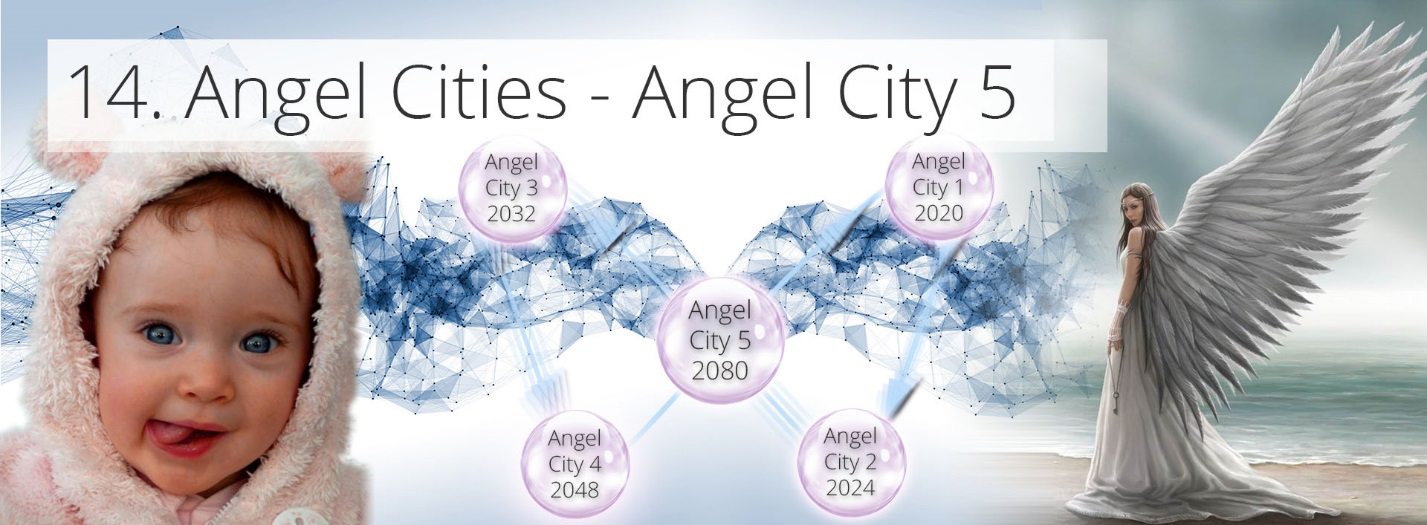
Angel City 5 is the last of the founding S-World Angel Cities set in 2080. Above, we see my darling daughter Sienna as herself and as an angel guiding us towards a better future, in keeping with the S-World mantra by Professor Isaac Asimov…
“You may not predict what an individual may do, but you can put in motion things that will move the masses in a direction that is desired, thus shaping if not predicting the future.”

This future <> past relationship is in a constant superflux; but one thing is constant, our ambition, the set of ‘super projects’ that are to be achieved.
In Game Theory and military strategy, they call it ‘Commander’s Intent’ (but instead of ‘take that hill, it’s ‘make them projects’), as commanders know that the best laid plans can quickly fall apart in battle. We must allow for every eventuality when creating the strings and manage the ripple effects that lead to the creation of our ‘special projects.’
However, once enough strings and ripples have congregated, it gets easier. For example, the first of the 16 Special Projects: ‘Experience Africa’ is underway and has become entangled as Angel City 1. Lake Malawi.
End of Extract
www.angeltheory.org/book/1-3/the-s-world-ucs-m-systems
The following chapter then presents the 16 philanthropic and ecological super projects:
www.angeltheory.org/book1-4/an-ecological-and-philanthropic-theory-everything-plus-space…
Which was later followed up with the breakthrough chapter from Book 3, which showed how all special projects and another 10 were created as a consequence / ripple effect of creating a Grand Network (land, infrastructure, industry, companies, real estate, and many other items) in a country in abject poverty, such as Malawi.
www.angeltheory.org/book3-14/ripple-effects-and-elephants-for-paul-g-allen
Per the equality M-System. 15. Angel POP which can now be summed up in one line.
“Grand Networks in areas of Abject Poverty are Special Projects”
Before we move onto the next chapter, let us once more look at the M-Systems design and note of M-System 15. ‘Angel POP – A Philanthropic Theory of Everything.’
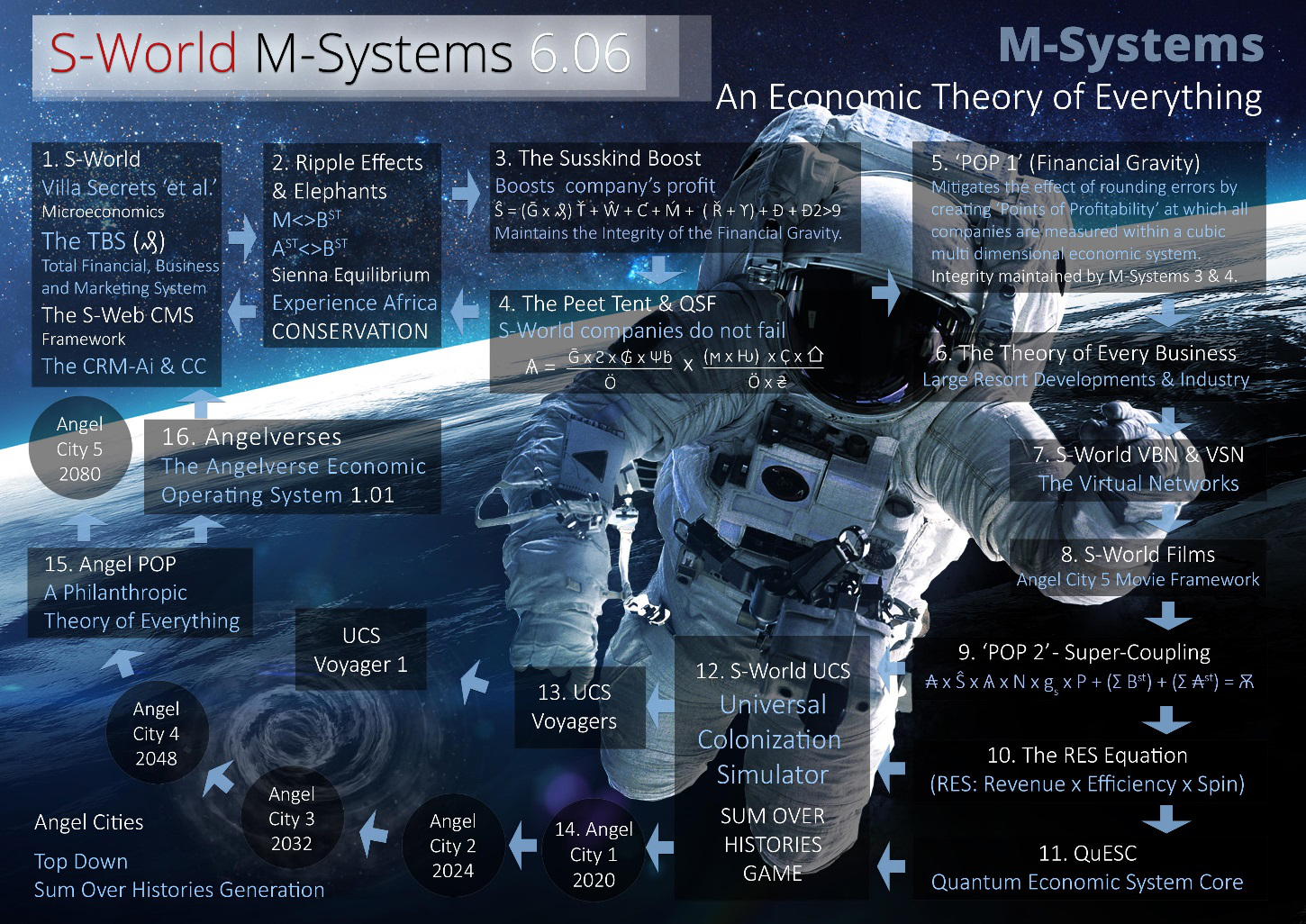
And in addition, let’s look at the later systems design for the ‘E-TOE’ as is featured in Book 2. Part 1. ‘Out of Chaos’; which presents the original theoretic influences, and asks the question ‘M-Theory, an Economic Science?’
We have taken an already creative network design 5 years in the making, and in 2016 fashioned it around the model/framework described by Hawking in this chapter; using simulations and mimicry from other good models from M-theory as a guide, and the result has the potential to cause a Paradigm Shift in economics, nudging the world in the desired direction.
